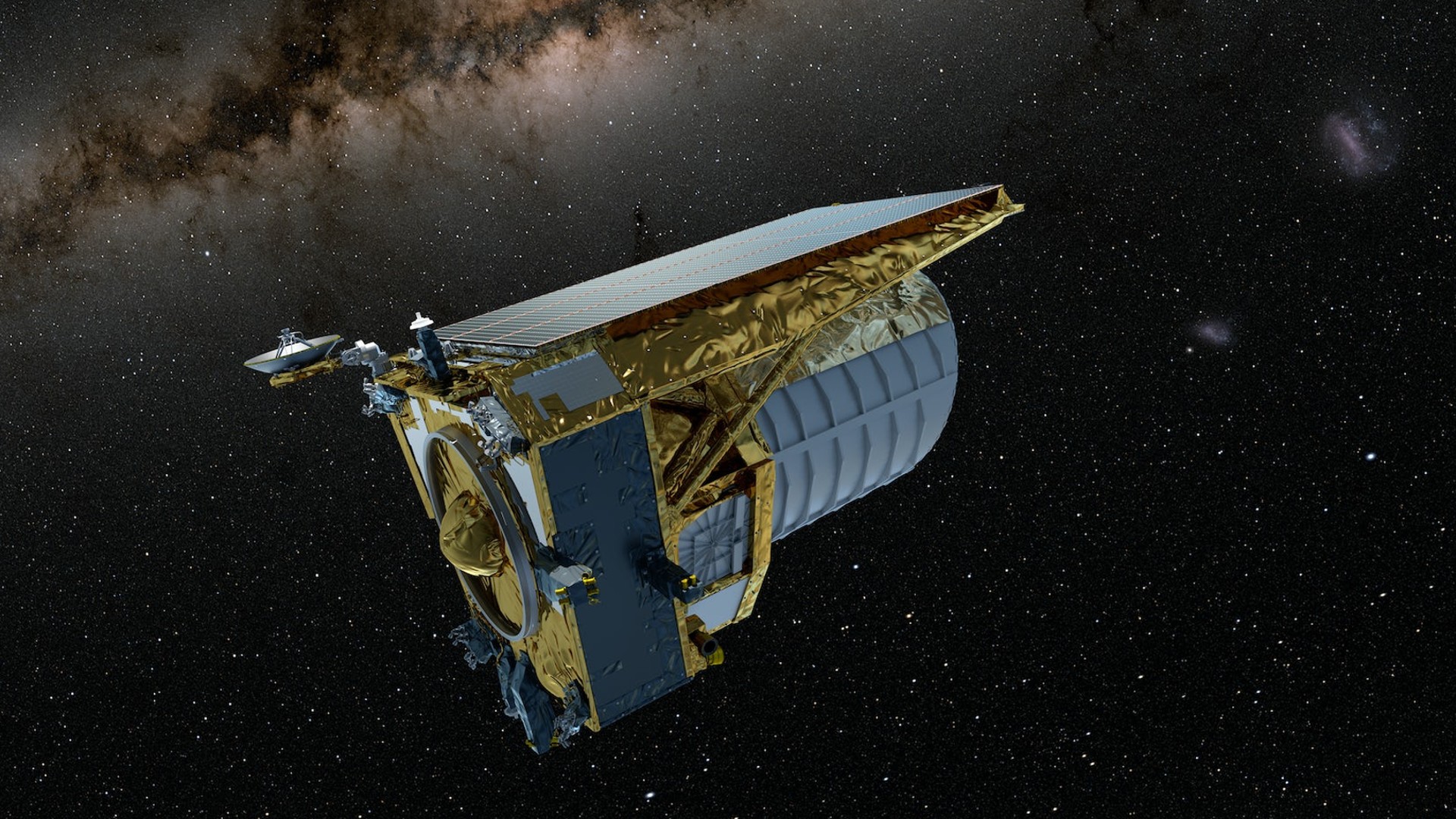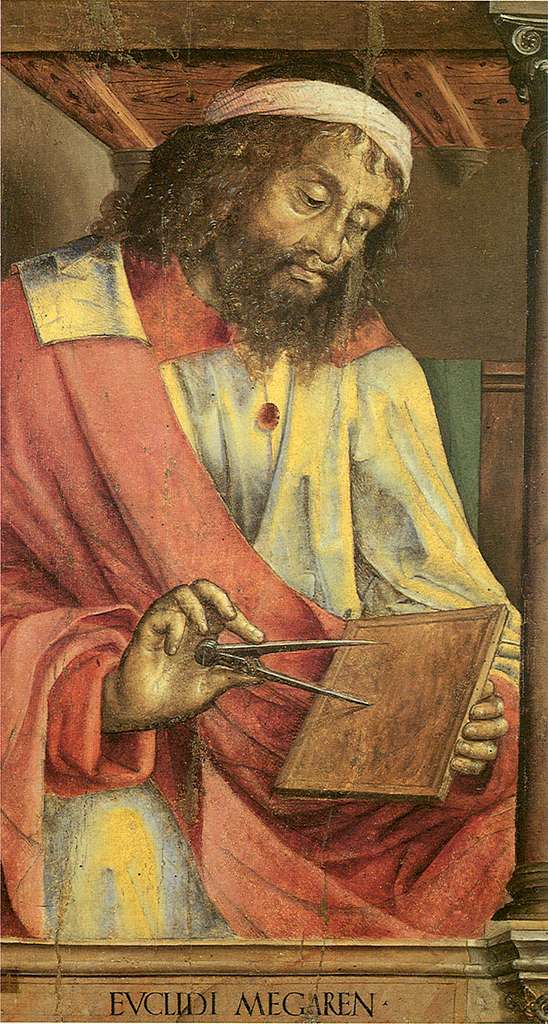
Scientists are about to get a new tool to uncover some of the most elusive mysteries of our universe.
The European Space Agency's Euclid mission, which is set to launch on July 1, is designed to study the so-called "dark universe." This is how scientists refer to the more mysterious components of the cosmos, namely dark matter and dark energy. To do so, this cutting-edge mission will employ some of the principles of geometry laid down by its ancient Greek namesake, the mathematician Euclid of Alexandria.
But who exactly was Euclid, and why is he still so important?
Related: Euclid mission: ESA's hunt for dark matter and dark energy
What is the Euclid mission?
The Euclid spacecraft contains a 3.9-foot-wide (1.2 meters) telescope — half the size of the Hubble Space Telescope — that can view the universe in visible and near-infrared light. Unlike Hubble and the James Webb Space Telescope, which are designed with narrow fields of view for close-up, high-resolution work, Euclid is taking a wide-angle approach that can encapsulate thousands of distant galaxies at a time.
Its field of view is 0.57 square degrees, which is just less than twice the diameter of the full moon. For a telescope, this is a huge expanse of sky to see in one shot, and it will allow Euclid's two instruments — its Visible Imager (VIS) and its Near-Infrared Spectrometer and Photometer (NISP) — to probe 1.5 billion distant galaxies in just six years to learn more about dark matter and dark energy. These two mysterious components make up 26.8% and 68.3% of the universe, respectively, but astronomers do not know what they are; we only know these dark elements are there because of invisible dark matter’s gravitational effect and the way dark energy is accelerating the expansion of the universe.
The density of matter and energy in the cosmos determines the geometry of the universe, in the sense that matter and energy can warp space-time, or stretch it. Since dark matter and dark energy make up the vast majority of matter and energy in the universe, it is they that truly control the universe’s geometry.
Euclid will study these dark influences in two ways. One is to look at how galaxies cluster by conducting a survey that catalogs galaxy redshifts to create a three-dimensional map of galaxies stretching across 10 billion light-years. How galaxies are clustered relates back to fluctuations in the density of matter in the cosmic microwave background (CMB), radiation emitted just 279,000 years after the Big Bang that created the universe. Comparing those fluctuations — called baryonic acoustic oscillations (BAOs) — with the size of clusters at later epochs can tell us about how the strength of dark energy has changed over time, because its repulsive force works against the gravity that causes galaxies to cluster.
The other way in which Euclid will study the dark universe is by looking at the shapes of galaxies. The gravity from dark matter spread across the universe can create gravitational lenses that bend light. We see this in dramatic fashion in the strong gravitational lenses of galaxy clusters, but dark matter can also cause "weak lensing" that subtly distorts the shapes of galaxies by altering the geometry of space and the path that light takes to reach us. Euclid will image 1.5 billion galaxies and look for those shape distortions to allow astronomers to map dark matter in the universe.

Who was Euclid the mathematician?
The mission is named after the father of geometry, the ancient Greek mathematician Euclid. (That’s his anglicized name, his Greek name was Eukleides). He lived around the year 300 BCE in the city of Alexandria, which was founded by Alexander the Great in 330 BCE. No one is entirely sure of Euclid’s personal details, including when exactly he was born and died. What we do know are what he left us: his great works of mathematics, particularly "Elements," a treatise on geometry and one of the most widely translated books in the world.
As such, Euclid has become known as the "father of geometry." Much of what Euclid the space mission will do relies on geometry, and how gravitational lensing and cosmic expansion alters that geometry.
In particular, we call Euclid's particular brand of geometry "Euclidean geometry." It's the geometry that you're taught in school, of flat planes, parallel lines, right angles, trigonometry and the Pythagorean Theorem.
Euclid based his geometry on a foundation of five axioms, or accepted truths. These include the fact that any two points can be joined by a straight line; straight lines can be extended indefinitely; a circle can be drawn by simply knowing where its centre is and the size of its radius; that all right angles (90 degrees) are equal; and that if a straight line X intersects two other straight lines, Y and Z, and if the angles X makes with Y and Z respectively are less than 90 degrees, then Y and Z will cross each other if extended indefinitely (in other words, forming a triangle).
From this foundation, Euclid was able to formulate a geometrical system that we still use 2,300 years later in everyday life. However, astronomers are able to look for deviations from Euclidean geometry in space, such as in gravitational lenses, to search for evidence of the dark universe.
Euclid of Alexandria's legacy will live on forever. He was a genius of his time, dabbling also in perspective geometry, algebra and so-called "spherical astronomy," which involves a form of geometry for finding objects on the celestial sphere. There's some evidence suggesting that Euclid was a student of Plato and taught at Alexandria's Museum, which was home to the famous Library of Alexandria and where he also set up a famed school of mathematics.
Now, over two millennia later, his legacy will enter the final frontier in our best attempt yet to get to the bottom of some of the most confounding mysteries of our universe.
Additional Resources
You can read more about the Euclid mission on the website of the Euclid Consortium, the collaboration of institutions and organizations behind the mission to map the dark universe. NASA also has a stake in the mission, having provided the infrared detectors and being involved in the analysis of the data that Euclid will collect.
Bibliography
— European Space Agency, The Euclid Consortium, Partnerships and Euclid Flagship Mockup Galaxy Catalog: https://www.eoportal.org/satellite-missions/euclid#the-euclid-consortium-partnerships-and-euclid-flagship-mockup-galaxy-catalog
— University of St Andrews, Euclid of Alexandria: https://mathshistory.st-andrews.ac.uk/Biographies/Euclid/
— Mark Cropper et al, VIS: The Visible Imager for Euclid: https://arxiv.org/pdf/1608.08603.pdf
—European Space Agency, Euclid VIS Instrument: https://sci.esa.int/web/euclid/-/euclid-vis-instrument
— European Space Agency, Euclid NISP Instrument: https://sci.esa.int/web/euclid/-/euclid-nisp-instrument
— Chris North, University of Cardiff, the Planck Satellite: Cosmic Microwave Background: https://plancksatellite.org.uk/results/cosmic-microwave-background/
— University of Geneva, Euclid in a Nutshell: Looking Through the Universe: https://www.isdc.unige.ch/euclid/
— European Space Agency: What Are Baryonic Acoustic Oscillations? https://sci.esa.int/web/euclid/-/what-are-baryonic-acoustic-oscillations-
— European Space Agency: What is Gravitational Lensing https://sci.esa.int/web/euclid/-/what-is-gravitational-lensing
— Bartel Leendert van der Waerden and Christian Marinus Taisbak, Encyclopaedia Britannica, Euclid: https://www.britannica.com/biography/Euclid-Greek-mathematician
— Benjamin Wardhaugh, Princeton University: Who Was Euclid https://press.princeton.edu/ideas/who-was-euclid
— J. L. Heiberg, Richard Fitzpatrick, Euclid’s Elements of Geometry: https://farside.ph.utexas.edu/books/Euclid/Elements.pdf
— John D. Norton, University of Pittsburgh: Euclidean Geometry: The First Great Science: https://sites.pitt.edu/~jdnorton/teaching/HPS_0410/chapters/non_Euclid_Euclid/index.html
— Norman Swartz, Simon Fraser University: Axioms and Postulates of Euclid: https://www.sfu.ca/~swartz/euclid.htm
— Mostafa El-Abbadi, Encyclopaedia Britannica: Library of Alexandria: https://www.britannica.com/topic/Library-of-Alexandria







